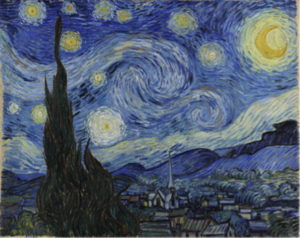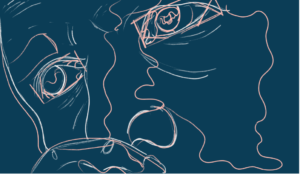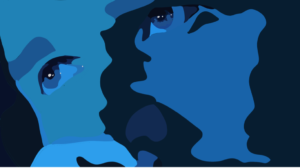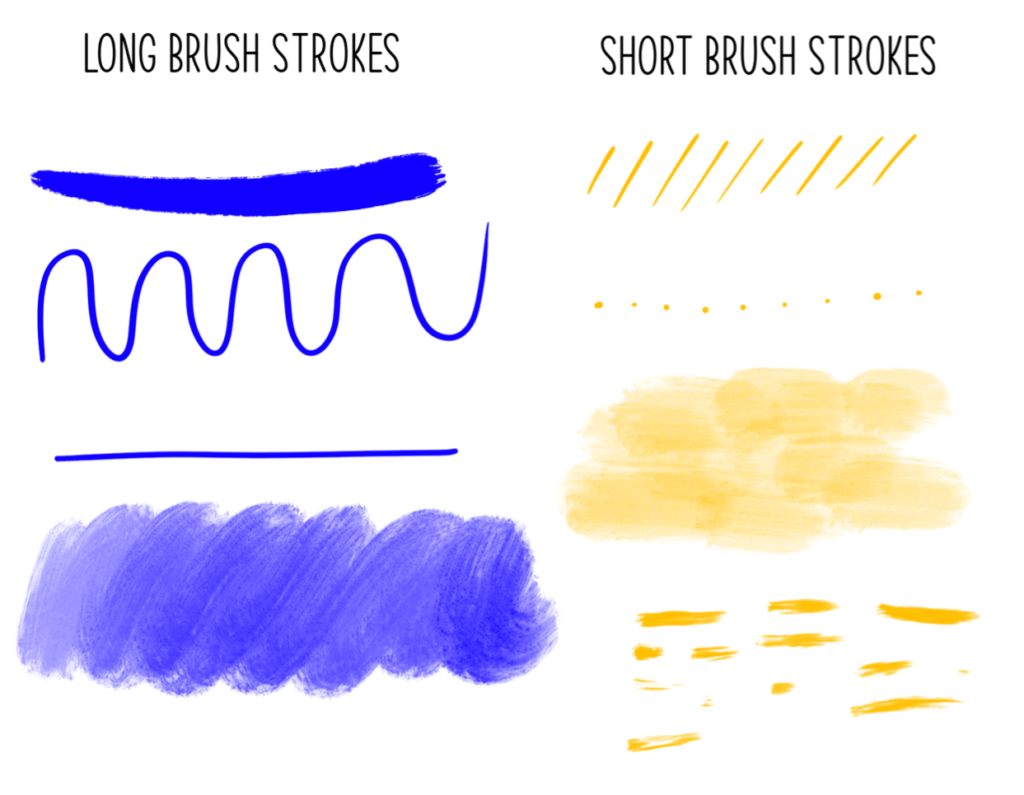Hey there InsideOuters!
Welcome to Part 2 of our Overcoming Art Block series! In Part 1, I shared a method for unlocking your creativity. In today’s post, I will walk you through how I used this method and drew inspiration from a famous piece to create a piece of my own!

I chose a piece everyone is familiar with, Vincent Van Gogh’s Starry Night (Figure 1). Van Gogh created this post-Impressionist piece in 1889 by applying oil paint to canvas with an impasto technique. Impasto is a painting method where the paint is placed very thickly on the canvas to add texture, which makes the brush or pallet placement clearly visible to the viewer. And by the way, if you want to check this piece out in person, stop by the Museum of Modern Art (MoMA) next time you’re in NYC.
I knew I wanted to draw a portrait. I was inspired from the YouTube video by Bo Burnham: ALL EYES ON ME (check it out!).
If you recall from Part 1, my suggestion for freeing yourself from ArtBlock was to change something about the piece you were using for inspiration to make it your own. I achieved this by using a different technique (modern) and a new medium (digital). In case you aren’t familiar with digital drawing, it can be done using a computer mouse or trackpad, an iPad/tablet, or even a tablet specially designed for drawing. I opted to use an iPad and program called Procreate because I thought I would feel more comfortable drawing with a pen-like object rather than a mouse or trackpad.

From here, I broke the subject down into the most basic geometry and components (Figure 2).
Next, I refined the outlines I created above and shaped them a bit more like the face I was attempting to recreate. To achieve this, I started with the simple shapes I had drawn and adjusted the lines to resemble the shapes of the eyes more closely, or the nose, or curves of the face (Figure 3).

Once I was happy with how my lines looked, I then began to block off different areas of the piece using color. One way to “block” or section a piece of art is to break it down into shadows and highlights. You can make this as simple or complex as you’d like. As you can see, in my piece, I decided to focus on shadows, highlights, and mid-tones (the areas in between) (Figure 4).

For my color pallet, I chose to go with more basic colors, meaning I selected colors that were very similar to one another rather than using a lot of different colors. I wanted to focus more on creating a sense of movement in the piece and did not want to break up the flow by using a lot of different colors. You can see the difference in the pallet examples here:


Colors are one way of adding detail to your art, but you can also add detail through the lines you draw. I wanted most of the detail to come from the line work rather than the color. I wanted to recreate the movement present in Starry Night and I thought the best way to achieve that would be through line work. You can see different ways of drawing lines in art in cute figure 5.

To stay true to the post-Impressionist style that I was trying to imitate, I needed to pay attention to my brush stroke direction and placement. The piece would lose its sense of “movement” if the brush strokes were not aligned, for example. Below, you can see how I planned out the direction I wanted my brush strokes to go, which helped me be mindful of the direction I was going to paint in and how to make everything flow together (Figure 7).
Finally, I started placing color down using very short brush strokes and varying the colors. I repeated this step until I had layers of brush strokes and colors moving in all the directions I had mapped out. You can see the final piece below!

Creating this piece certainly was a challenge for me in many ways! So, what did I learn?
First, I learned a new style and medium. I think my piece falls into the modern Post-Impressionist category– a style that I am not very familiar with! As many of you are probably aware, Impressionist art reflects the artist’s attempt to recreate the immediate physical impression they had of a scene or an object. I knew I wanted to get practice recreating the movement present in Starry Night and I thought the best way would be through line work. But, I also wanted to create a portrait. I would have never normally attempted to represent a portrait using short line work (aka Impressionist style)– because to me, that seemed too hard. It turns out that it was not hard at all and actually fun to do using digital drawing— a medium I’m not very familiar with!
Second, by examining another artists’ work in depth, I had a chance to appreciate their art and discover new ways to express myself that I would not have normally done, which helped me break free of my “art block.” It can be easy to get overwhelmed by a task such as “draw this thing” – but when you start to investigate in depth how someone else has done it, it seems more manageable.
In summary, the best advice I can give for tackling your creative blocks would be to just jump into something and try it out. If you have an idea and are not sure how to execute it or how it will turn out, just give it a try and see what happens. You might discover new creative ways to achieve the result you want, or you might just learn a new technique and strategy to apply to another piece you want to make. And, if you are interested in trying out digital art, check out some of these online tutorials:
https://digitalarttutorials.com/
https://www.youtube.com/watch?v=0RmGV5wALG0
https://www.youtube.com/watch?v=wZNq9OI1S3M
Finally, a huge thank you to folks who submitted their art to the Art Block Challenge! Stay tuned for Part 3 of Overcoming Art Block, in which we will showcase their work. And, if you haven’t gotten a chance to submit something yet, check out this post and challenge yourself!



